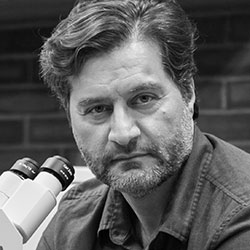Advisor Faculty Research Interests and Projects (A-O)
D.O./Ph.D. Physician Scientist Training Program
Kurt Amsler, Ph.D., Professor, Department of Biomedical Sciences

A basic feature of multicellular organisms is the formation of body compartments separated by cell layers, e.g., epithelial cells and endothelial cells in mammals. Cell layers separating the body compartments allows the organism to modify differentially the two compartments by regulating the movement of water and solutes. There are two mechanisms by which water and solutes move across the cell barrier, the transcellular mechanism (compounds are moved into and out of the cells by individual transporters) and the paracellular mechanism (compounds move between the cells in the barrier). The regulated movement of water and solutes across cell layers/barriers is an essential function of virtually all multicellular organisms. While transcellular solute movement has been a subject of intense study for more than 100 years and is relatively well-understood, the basis and regulation of paracellular solute and water movement has only recently become a focus for scientific investigation.
MORE
In humans and many/most other animal species, the paracellular movement of solutes and water is restricted by the tight junction (or an analogous structure). Paracellular solute and water movement is critical for the normal physiological function of the body and is central to multiple pathophysiological conditions. The paracellular mechanism is currently believed to consist of two pathways, the pore pathway (mediated by a family of proteins called claudins) and the leak pathway. The mechanism mediating the leak pathway is still unclear. Recent work on Xenopus laevis gastrulation has raised a potential mechanism which forms the basis for this proposal. Identification of the mechanism mediating the leak pathway would be a significant advance that will have major implications for mammalian physiology and pathophysiology.
Our laboratory has been investigating the mechanism and regulation of paracellular permeability across mammalian epithelia using both a renal epithelial cell culture model system and the in vivo rat kidney. We are studying both the mechanistic basis of the leak pathway and the regulation of the leak pathway under both physiological and pathophysiological conditions, e.g., renal ischemia/reperfusion injury. We have previously shown that treatment of renal epithelial cells in culture with hydrogen peroxide, a model for renal ischemia/reperfusion injury, and induction of renal ischemia/reperfusion injury in vivo increase leak pathway permeability. This increase requires activation of the ERK 1/2 signaling pathway. Depletion of renal cells for the tight junction associated protein ZO-1 increases leak pathway permeability and eliminates the ability of hydrogen peroxide to further increase leak pathway permeability. Depletion of the actin-organizing protein TOCA-1 also increases leak pathway permeability and decreases the response to hydrogen peroxide. The content of the tight junction protein occludin is inversely correlated with the ability of hydrogen peroxide to increase leak pathway permeability, i.e., the more occludin, the weaker the hydrogen peroxide effect. We have also demonstrated that the response of renal epithelial cell in culture to hydrogen peroxide is acquired after cells attain a confluent cell density and cease cell proliferation, suggesting a developmental regulation of this process.
Our current working hypothesis is that cell strain/tension on the tight junction causes localized depletions of ZO-1 protein from the tight junction. The sites of localized ZO-1 depletion are the sites of leak pathway permeability with the size of the solutes that can pass being determined by the area of ZO-1 depletion. This ZO-1 depletion initiates a series of events starting with localized activation of RhoA at these sites of ZO-1 depletion, so-called “rho flares”. Activated RhoA induces organization of a localized F-actin network to stabilize the weakened tight junction and to recruit more tight junction proteins to reform the stable tight junction. Events which increase strain/tension on the tight junction increase the number of these weakened tight junction regions leading to increased leak pathway permeability. The induction of rho flares and the subsequent events restabilize the tight junction region and decrease leak pathway permeability back to normal.
Brian Lee Beatty, Ph.D., Associate Professor, Department of Anatomy

My research tends to focus on a variety of topics from evolutionary biology to clinical anatomy. While the topics and questions may vary, I prefer to approach questions that focus that explore the interface between surfaces and microstructure in biological systems at the microscopic level. This includes methods such as histology/histopathology, surface metrology, and radiographic methods.
MORE
Histology/histopathology – This involves tissue sampling, slides, and staining as one might expect. The only difference is that I prefer to do image analyses that allow us to quantify the data we get precisely. Surface metrology – This is fairly novel. I’ve been using a white light reflectance confocal microscope to scan the tiny surfaces of anatomical structures (vessels, bones, skin, etc.) to create a 3D surface topography that is quantitatively measured. Its analytical power can be overpowered, but it can allow us to do some pretty surprisingly useful analyses of surfaces that matter in biological terms. microCT – We have a new microCT in the dept of Anatomy. This will allow for a number of fine detailed approaches to investigating bones and soft tissues at a nearly histological level in three dimensions. The intention is to utilize iodine staining (dice CT) to visualize soft tissues this way.
Projects
Quantitative measures of enthesis surface roughness and its relationship to muscle/ligament attachment
I am interested in seeing how the surface texture of bones differs quantitatively where muscles and tendons of various types and strengths attach. This is a fairly complex project that has implications for orthopedics and bone biology, as well as paleontological inferences. This is likely to expand into investigations into other soft tissue structures in contact with bone (sinus mucosae, cartilage, joint capsules). Many bone pathologies also have a textural component to their description that is rather subjective that I would like to make quantitative. Plans to sample human specimens from the Mütter museum in Philadelphia are already underway.
Hoehmann, C. & Beatty, B. L. (in review) Surface metrology of bone surface attachments of knee ligaments. Bone
The relationship between atherosclerosis and endothelial roughness
I am generally using histopathology and surface metrology to examine the connection between the microscopic roughness of the endothelium and the disease state of a vessel. I tend to focus on a particular region of the body or set of vessels (coronary, large aortic branches, etc.) and then do the surface metrology and histopathology to evaluate the relationship between calcification and surface roughness.
Hoehmann, C. L., B. Futterman, and B. L. Beatty. 2017. Peripheral Arteries May Be Reliable Indicators of Coronary Vascular Disease. The Anatomical Record 300:1230-1239.
Schear, M. & Beatty, B.L. (2014) A histological investigation into the correlation of central retinal artery atherosclerosis with the systemic circulation. The Anatomical Record 297(8):1430-1434.
Development of a non-invasive diagnostic tool for dermatopathology
I have a small project on matching skin histopathology to surface metrology, particularly with regard to keratosis and skin cancer. The goal is for it to become a diagnostic tool.
Ciano, J. & Beatty, B.L. (2015). Regional quantitative histological variations in human oral mucosa. The Anatomical Record 298(3): 562-578.
Weikang Cai, Ph.D., Assistant Professor
Role of astrocytes on the modulation of brain metabolism and behavior in normal and disease states.
Brain is one of the most heterogeneous organs in the body. It is composed of many neuronal and non-neuronal cell types. Astrocytes are the most abundant glial cells in the brain. They play many fundamentally important roles for normal brain function, including brain metabolism, synaptic homeostasis, blood-brain barrier integrity and injury repair. More recently, astrocytes have been shown to be an active component within the neural circuitry, by releasing “gliotransmitters” such as glutamate, D-serine and ATP to modulate nearby neuron activities and behavior in mice. More importantly, abnormal astrocyte density and function are evident in many types of neurological diseases, including Alzheimer’s disease, major depression, stroke, and diabetes, implicating important roles of astrocytes in the progression of these diseases.
MORE
The main research interest of Dr. Cai’s laboratory is to understand the molecular mechanisms by which astrocytes respond to external signals to modulate brain metabolism, neuronal activity, and behavior. Further, we aim to investigate the contribution of these astrocyte-dependent mechanisms on the progression of neurological complications related to diabetes, including depression, and painful neuropathy. We use both in vitro (primary cell cultures) and in vivo (transgenic mice) models to understand this crosstalk between astrocytes and neurons. Trainees in the lab are expected to lead an independent research project within the scope of our research interest. They will receive extensive trainings from basic biochemistry, molecular biology, to integrated physiology and neurobiology.
Project 1: Insulin signaling in astrocytes, dopamine system and depression
Diabetes increases the risk to develop major depression. Our previous studies show that astrocytes play a pivotal role in modulating depressive-like behavior in mice through regulating dopamine system. Thus, insulin signaling directly regulates ATP exocytosis from astrocytes to modulate dopaminergic presynaptic neuronal activity. Loss of insulin signaling in astrocytes impairs ATP release from astrocytes, which is sufficient to cause depressive-like behavior in mice. Moving forward, we will continue to investigate the molecular mechanisms by which insulin signaling controls ATP release in astrocytes, thus dopaminergic neuronal activity. We use both genetic and acquired insulin resistant mouse models to further understand the impact of diabetes and insulin resistance on astrocyte-dependent modulation on dopamine system and depressive-like behavior.
Project 2: Astrocytes, somatosensory neural circuit and painful diabetic neuropathy
Peripheral diabetic neuropathy is the most common complications of diabetes. More than 60% of diabetic patients may develop peripheral diabetic neuropathy. Many of these patients suffer excessive pain to commonly non-painful stimuli, such as gentle touch. However, the mechanism for this hypersensitivity of somatosensory neural circuit is still not fully understood. Astrocytes and purinergic signaling have been implicated in the somatosensory neural circuit and abnormal pain sensitivity. Our lab aim to study the contribution of astrocytes and its related function on the somatosensory processing at spinal and supraspinal levels in mouse models of diabetes.
Selected Publications
Soto M*, Cai W*, Konishi M, Kahn CR. Insulin signaling in the hippocampus and amygdala regulates metabolism and neurobehavior. Proc Natl Acad Sci U S A. 2019 Mar 26;116(13):6379-6384. PubMed PMID: 30765523. *These authors contributed equally.
Batista TM, Garcia-Martin R, Cai W, Konishi M, O'Neill BT, Sakaguchi M, Kim JH, Jung DY, Kim JK, Kahn CR. Multi-dimensional Transcriptional Remodeling by Physiological Insulin In Vivo.Cell Rep. 2019 Mar 19;26(12):3429-3443.e3. PubMed PMID: 30893613.
Bou Karam J, Cai W, Mohamed R, Huang T, Meng L, Homan EP, Dirice E, Kahn CR, El Ouaamari A. TRPV1 neurons regulate β-cell function in a sex-dependent manner. Mol Metab. 2018 Dec;18:60-67. PubMed PMID: 30473098.
Cai W, Xue C, Sakaguchi M, Konishi M, Shirazian A, Ferris HA, Li ME, Yu R, Kleinridders A, Pothos EN, Kahn CR. Insulin regulates astrocyte gliotransmission and modulates behavior. J Clin Invest. 2018 Jul 2;128(7):2914-2926. PubMed PMID: 29664737.
Altindis E, Cai W, Sakaguchi M, Zhang F, GuoXiao W, Liu F, De Meyts P, Gelfanov V, Pan H, DiMarchi R, Kahn CR. Viral insulin-like peptides activate human insulin and IGF-1 receptor signaling: A paradigm shift for host-microbe interactions. Proc Natl Acad Sci U S A. 2018 Mar 6;115(10):2461-2466. PubMed PMID: 29467286.
Cai W*, Sakaguchi M*, Kleinridders A, Gonzalez-Del Pino G, Dreyfuss JM, O'Neill BT, Ramirez AK, Pan H, Winnay JN, Boucher J, Eck MJ, Kahn CR. Domain-dependent effects of insulin and IGF-1 receptors on signalling and gene expression. Nat Commun. 2017 Mar 27;8:14892. PubMed PMID: 28345670. *These authors contribute equally.
Kleinridders A, Cai W, Cappellucci L, Ghazarian A, Collins WR, Vienberg SG, Pothos EN, Kahn CR. Insulin resistance in brain alters dopamine turnover and causes behavioral disorders. Proc Natl Acad Sci U S A. 2015 Mar 17;112(11):3463-8. PubMed PMID: 25733901.
Complete List of Published Work in Bibliography:
https://www.ncbi.nlm.nih.gov/sites/myncbi/1xUey8pIhznQz/bibliography/44415758/public/?sort=date&direction=descending
Maria Alicia Carrillo-Sepulveda, Ph.D., Assistant Professor, Department of Biomedical Sciences

Vascular Complications in Diabetes and Metabolic Syndrome.
The primary goal of my research is to understanding how altered metabolic conditions found in diabetes and metabolic syndrome leads to microvascular and macrovascular complications. We utilize in the lab physiological approaches, including murine models of type 2 diabetes and metabolic syndrome, and primary vascular cell cultures to investigate the molecular mechanisms. Although current anti-hyperglycemic drugs utilized to treat diabetic patients have effectively controlled their glucose levels, these patients still suffer from vascular complications. Thus, understanding the mechanisms of vascular dysfunction in diabetes may contribute to identify potential targets that will alleviate diabetes-induced vascular complications such as atherosclerosis, coronary disease and hypertension. In addition, our lab is also studying the effects of westernized diets, a metabolic stressor present in our modern life, in the vascular function.
MORE
Project 1: The effects of westernized diets in the vascular function
Overconsumption of a diet rich in fat and carbohydrates, called the Western diet, is a major contributor to the global epidemic of metabolic syndrome and consequently cardiovascular disease. We have established a model of Western diet-induced metabolic syndrome in female rats. Using this model, we have recently found that Western diet causes vascular dysfunction in female rats via mechanisms that involves endothelial Toll-like receptor 4 (TLR4) signaling, a key component of the innate immune system. Next, we will study whether other inflammatory signaling pathways are also contributing for the diabetic vascular complications.
Selected publications
Kramer B, Franca LM, Zhang Y, Paes AMA, Gerdes AM, Carrillo-Sepulveda MA. (2018) Western diet triggers Toll-like receptor 4 signaling-induced endothelial dysfunction in female Wistar rats. Am. J. Physiol. Heart Circ Physiol. 315(6):H1735-H1747. doi: 10.1152/ajpheart.00218.2018.
Project 2: Vascular Dysfunction in Diabetes
We have previously identified that Toll-like receptor 4 (TLR4) plays an important role in the vascular dysfunction found in diabetic conditions. We are now interested to identify potential post-translational modifications (PTM) of vascular proteins, including lysine acetylation. This project has used different murine models of type 2 diabetes.
Selected Publications
Carrillo-Sepulveda MA, Spitler K, Pandey D, Berkowitz DE, Matsumoto T (2015). Inhibition of TLR4 attenuates vascular dysfunction and oxidative stress in diabetic rats. J Mol Med. 93 (12): 1341-54. doi: 10.1007/s00109-015-1318-7. Epub 2015 Jul 17.
Jonathan Geisler, Ph.D., Associate Professor, Department of Anatomy

My overall research goal is to understand the evolutionary origins of complex anatomical adaptations. To do this I have focused on cetaceans (whales, dolphins, and porpoises), whose extreme and highly unusual anatomy are ideal for investigating developmental and functional constraints on mammalian anatomy. Ongoing research focuses on several systems/anatomical structures that have undergone adaptations in this group, including the inner ear, nasal passages, viscerocranium, neurocranium, forelimb, and axial skeleton. Evolutionary history canalizes subsequent anatomical evolution, thus I am also actively involved in integrating anatomic and genetic data to understand the phylogeny of mammals.
MORE
Selected Publications
- Geisler, JH., Boessenecker, RW., Brown, M., and Beatty, BL. (2017) The origin of filter feeding in whales. Curr. Biol. 27(13):2036-2042.
- Churchill, M., Martinez-Caceres, M., de Muizon, C., Mnieckowski, J., and Geisler, JH. (2016) The origin of high-frequency hearing in whales. Curr. Biol. 26:2144-2149.
- Geisler, JH., Colbert, MW., and Carew, JL. (2014) A new fossil species supports an early origin for toothed whale echolocation. Nature 508:383-386.
- Montgomery, SH., Geisler, JH., McGowen, MR., Fox, C., Marino, L. and Gatesy, J. (2013) The evolutionary history of cetacean brain and body size. Evolution 67:3339-3353.
Project 1: Allometry of the inner ear in mammals and the importance of functional constraints.
Not surprisingly, there is positive allometry between components of the inner ear and overall body size across mammals; however, functional constraints strongly affect this relationship, particularly in large or small-bodied species. In addition, there is some evidence that morphology correlates with size, suggesting a complex interplay between the physics of sound transmission, sound amplification, and the absolute size of structures of the inner ear. Student(s) in this project will acquire a diverse sample of inner ear data using the microCT in NYIT’s Data Visualization Lab, document and investigate patterns of shape variation using 3D geometric morphometrics, develop fluid models of the cochlea based on microCT data, and manipulate these models to test hypotheses relating cochlear size and shape to functional performance.
Project 2: Relationship between cochlear morphology and bone versus air conduction hearing.
Most, if not all, mammals can perceive sounds that bypass the middle ear and travel through other bones of the skull. Some mammals, mainly subterranean or aquatic species, have highly specialized middle ear anatomy to enhance hear bone-conduction hearing. However, the question of whether the inner ear of bone-conducting specialists is similarly adapted is largely unstudied. Student(s) in this project will collect inner ear data using the microCT in NYIT’s Data Visualization Lab, develop fluid models of the cochlea based on microCT data, manipulate these models to test hypotheses relating shape to method of sound conduction, and finally trace the evolution of bone conduction in highly specialized mammals.
AM Gerdes, Ph.D. and KM Ojamaa, Ph.D., Department of Biomedical Sciences (co-mentors)

Background: Our group clearly demonstrated that chronic hypothyroidism (Hypo) alone can eventually lead to dilated heart HF1. All types of HF induce re-expression of fetal genes, similar to that induced by Hypo2. Indeed, it is likely that re-expression of fetal genes in heart diseases is due to low cardiac tissue TH levels. Many animal studies and short-term clinical studies have shown a wide array of improvements in HF after treatment with THs2. Treatment benefits from restoring TH function in HF have included improved LV systolic and diastolic function, reduced myocardial fibrosis and myocyte loss, improved ventricular remodeling, resistance to arrhythmia induction (rats), and improved vascular function2. Our animal work has also shown that cardiac tissue TH levels may be reduced despite normal serum TH hormones2. Unfortunately, fear that overdosing will lead to arrhythmias and the general belief that THs are too dangerous to use in HF patients have impeded implementation of large scale clinical trials. What is clearly needed for optimum treatment of cardiac patients is a reliable serum hormone biomarker for low cardiac tissue TH function.
MORE
After a thorough examination of existing information, we hypothesize that Brain Natriuretic Peptide (BNP) may be a reliable serum biomarker for low cardiac tissue T3. BNP is primarily produced in cardiac myocytes3, upregulated by increased myocyte stretch, and secreted into the blood to stimulate kidney diuresis3. Hypo induces upregulation of cardiac BNP mRNA and serum BNP, changes that are reversed by TH treatment4 (confirmed in our lab). While very high values for BNP are associated with HF, BNP is moderately increased by ~3 fold in non-cardiac patients with low T3 syndrome. Many studies show an inverse relationship between serum T3 and serum BNP, with the combination of low T3/high BNP being particularly predictive of worse outcomes. T3 treatment of HF patients with Low T3 syndrome significantly reduced serum BNP levels2. Cardiac BNP mRNA was upregulated in rats with MI and reduced to near normal values by T3 treatment5. Cumulatively, evidence suggests that moderately elevated serum BNP levels are likely to be predictive of low cardiac tissue TH function. Such modest elevations in BNP are largely overlooked but, evidence cited above, suggest BNP may be a predictor of low cardiac TH function. BNP is also upregulated in thyrotoxicosis where myocyte stretch appears to be a major stimulus. Since THs would not be considered in the treatment of hyperthyroid patients, the more complex issue of BNP and hyperthyroidism should not pose a problem with treatment decisions. In the current proposal, BNP expression will be measured in the context of cardiac tissue TH function as determined by changes in cardiac TH responsive genes.
Experimental Design: A linear inverse relationship between cardiac tissue BNP mRNA and α-myosin/β-myosin mRNA (key fetal genes regulated by THs) will be confirmed in rats with TH function ranging from Hypo to normal (PTU+T3 model6). In subsequent experiments, the relationship between cardiac tissue TH function (α-myosin/β-myosin mRNA) and cardiac tissue BNP mRNA will be examined in rats with myocardial infarction with or without TH treatment. We will examine the reliability of serum BNP to predict the inverse relationship between cardiac tissue TH function and BNP in MI rats with and without T3 treatment. We also have 36 human cardiac tissue samples (24 HF and 12 unsuitable donor controls) from the heart transplant program at UPenn. This should enable confirmation of the inverse relationship between BNP and TH function in human heart.
1Tang YD, Kuzman JA, Said S, Anderson BE, Wang X and Gerdes AM. Low thyroid function leads to cardiac atrophy with chamber dilatation, impaired myocardial blood flow, loss of arterioles, and severe systolic dysfunction. Circulation. 2005;112:3122-30.
2Gerdes AM and Ojamaa K. Thyroid Hormone and Cardioprotection. Comprehensive Physiology. 2016;6:1199-219.
3Hajje G, Saliba Y, Itani T, Moubarak M, Aftimos G and Fares N. Hypothyroidism and its rapid correction alter cardiac remodeling. PLoS One. 2014;9:e109753.
4Zhang K, Tang YD, Zhang Y, Ojamaa K, Li Y, Saini AS, Carrillo-Sepulveda MA, Rajagopalan V and Gerdes AM. Comparison of Therapeutic Triiodothyronine Versus Metoprolol in the Treatment of Myocardial Infarction in Rats. Thyroid. 2018;28:799-810.
5Weltman NY, Ojamaa K, Savinova OV, Chen YF, Schlenker EH, Zucchi R, Saba A, Colligiani D, Pol CJ and Gerdes AM. Restoration of cardiac tissue thyroid hormone status in experimental hypothyroidism: a dose-response study in female rats. Endocrinology. 2013;154:2542-52.
Michael C. Granatosky, Ph.D., Assistant Professor, Anatomy

My research explores locomotor biomechanics in an evolutionary framework to address the overarching question: How to build a quadruped? Quadrupedal locomotion is an incredibly complex form of movement that requires animals to coordinate multiple oscillating anatomical regions through space and time. Furthermore, the neuromuscular substrates for quadrupedal movement are ancient and represent the primitive condition in which all other tetrapod locomotor modes are based. As such, it is impossible to explore important evolutionary events such as the fin-to-limb transition, the advent of flight, or the origins of bipedalism without first considering quadrupedal gait mechanics. With these considerations in mind, the question of "How to build a quadruped?" becomes a fascinating area of inquiry that requires a collaborative and interdisciplinary investigative approach. My research addresses this broad question through a neontological perspective using living animal models. Current projects in my lab include: using "walking" fish to investigate neuromuscular evolution and energetic costs during the fin-to-limb transition; exploring the importance of proprioceptive sensory information in dictating locomotor performance; and utilizing information gleaned from living animals to develop biomimetic machines.
MORE
Project 1: Assess the importance of sensory feedback for locomotor performance in tetrapods
When you or I walk, the way we move and load our limbs is remarkably consistent from step-to-step. This same pattern is observed in other mammals and birds. However, when one looks at locomotor characteristics of say a turtle, gecko, or alligator, a different story emerges. For these animals, spatiotemporal gait characteristics and limb-loading are highly variable. These differences among tetrapods are hypothesized to be a result of derived neuromuscular adaptions (e.g., Golgi tendon organ morphology, enlarged cerebellum, and γ-motoneuron innervation of muscle spindles) in birds and mammals compared to other tetrapods. By utilizing these "natural experiments" in sensorimotor evolution and animal models with targeted somatosensory loss, my lab explores the effects that proprioceptive sensory feedback has on gait transitions, overall locomotor energetics, and the ability to recover from unexpected perturbations.
Selected publications
- Granatosky, M. C., Bryce, C. M., Hanna, J., Fitzsimons, A., Laird, M. F., Stilson, K., Wall, C. E. and Ross, C. F. (2018). Inter-stride variability triggers gait transitions in mammals and birds. Proceedings of the Royal Society B 285.
- Granatosky, M. C., McElroy, E. J., Reilly, S. M., Lemelin, P., Butcher, M. T., Blob, R. W. and Ross, C. F. (in review). Variation in limb loading magnitude and timing in tetrapods. Journal of Experimental Biology.
Project 2: The evolution of the muscle spindle during the fin-to-limb transition
One of the greatest, but often underappreciated, innovations that occurred as tetrapods made their first forays onto land was the evolution of muscle-spindles, stretch receptors within the body of a muscle that primarily detect muscular length changes. While muscle-spindles have not been observed in non-tetrapod gnathostomes, certain benthic "walking" fishes do demonstrate an elaboration of free-nerve ending that have been hypothesized to report similar sensory feedback. However, there exists no experimental data to support this claim. This new project combines techniques in histology, neurophysiology, and locomotor biomechanics to assess the functional role of these elaborated free-nerve endings in "walking" fishes, and explores hypotheses about the initial origins and importance of muscle-spindles during the fin-to-limb transition.
Vladimir “Vlado” Grubisic, M.D., Ph.D., Assistant Professor

The role of enteric glia in intestinal function and intercellular signaling in health and disease
Basic functions of the intestines are under the direct control of the enteric nervous system or “the brain in the gut”, composed of neurons and glial cells residing in the gut wall. We earlier showed that enteric glia actively contribute to the regulation of basic intestinal reflexes such as gut motility and secretomotor function. The goal of this project is to investigate previously unrecognized roles of enteric glia in gut function and intercellular communication. The surface of the digestive tube serves as a semi-permeable barrier that absorbs nutrients and keeps microbes out of the system. It also communicates with the rest of the body through hormone and synaptic signaling. Enteric glia within the intestinal mucosa make intimate connections with the epithelium, neuronal processes, and immunocytes, but it is unclear how the mucosal glia regulate epithelial barrier function or the signaling.
MORE
Project 1: How enteric glia play a role in the intestinal epithelial barrier function?
Epithelial cell layer contributes the most to the intestinal barrier function and increased intestinal permeability or “leaky gut” is associated with a wide range of conditions. Despite important in vitro studies documenting the substantial role of cultured glia on the permeability of epithelial cell line monolayers, there is conflicting in vivo evidence if enteric glia substantially contribute to the maintenance and regulation of intestinal epithelium. Our work on ex vivo intestinal preparations shows that glia do not acutely regulate the permeability of healthy intestines, but have a substantial effect after acute intestinal inflammation. The goal of this project is to further probe cell and molecular mechanisms underlying glial regulation of the gut epithelial barrier (patho)physiology.
Selected publications
Grubišić V. and Gulbransen B. D. Enteric glial activity regulates secretomotor function in the mouse colon but does not acutely affect gut permeability. J. Physiol. 2017; 595(11): 3409-3424.
Grubišić V.*, Perez-Medina A. L.*, Fried D. E., Sévigny J., Robson S. C., Galligan J. J., Gulbransen B. D. NTPDase1 and -2 are expressed by distinct cellular compartments in the mouse colon and differentially impact colonic physiology and function after DSS colitis. Am J Physiol Gastrointest Liver Physiol. 2019; 317(3): G314-G332.
*Authors share co-first authorship.
Project 2: How enteric glia contribute to epithelial signaling and signal transduction?
Enteric glial activity is encoded by an increase in intracellular calcium concentration and modulates local neuronal reflex circuits that control gut motility and epithelial secretomotor functions. We documented possible direct signaling between the glial and epithelial cells. To goal of this project is to investigate molecular signaling between the intestinal epithelium and enteric glia. This functional interaction could play a role in the production of hormones and neurotransmitters that regulate homeostasis of the whole organism through gut-brain, gut-liver, and gut-pancreas axes.
Selected Publications
Grubišić V. and Gulbransen B. D. Enteric glial activity regulates secretomotor function in the mouse colon but does not acutely affect gut permeability. J. Physiol. 2017; 595(11): 3409-3424.
McClain J. L.*, Grubišić V.*, Fried D., Gomez-Suarez R. A., Leinninger G. M., Sévigny J., Parpura V., Gulbransen B. D. Ca2+ responses in enteric glia are mediated by connexin-43 hemichannels and modulate colonic transit in mice. Gastroenterology. 2014; 146 (2): 497-507. Epub 2013.
*Authors share co-first authorship.
Michael Hadjiargyrou, Ph.D., Professor, Department of Biological and Chemical Sciences

Molecular and cellular mechanisms of musculoskeletal development and regeneration
The overall goal of my research is to understanding the molecular mechanisms that underlie musculoskeletal development and regeneration and implement innovative approaches for engineering new musculoskeletal tissue utilizing knowledge derived from molecular and cellular biology and biomaterials. The repair of a fractured bone is a complex biological event that essentially recapitulates embryonic development and requires the orchestration of a number of different cell types undergoing proliferation, migration, adhesion and differentiation, all under the direct control of a host of different genes. Understanding the temporal and spatial expression of these genes during the progression of a healing callus will ultimately enable us to comprehend the essential processes of inflammation, chondrogenesis, ossification, and remodeling. In addition, we are also interested in understanding the process of myogenic differentiation and skeletal muscle development.
MORE
Project 1: Functional characterization of Mustn1
Mustn1 is a novel gene that we discovered a few years ago from our transcriptional profiling experiments on bone regeneration. The Mustn1 gene encodes for a 9.6 kDa nuclear protein whose expression is restricted to the musculoskeletal system. It is highly expressed in the developing embryo in somites, as well as limb buds. Functional perturbations in both chondrocytes and skeletal muscle cells in vitro suggest that this gene plays a regulatory role in the process of proliferation and differentiation. Further, functional perturbation of Mustn1 in vivo showed severe morphological defects in the craniofacial region, body axis and tail. We are now are further probing the molecular mechanisms of how Mustn1 regulates these developmental and regenerative processes by focusing on generating conditional knockout animals (in cartilage and skeletal muscle), identifying interacting proteins as well as signaling pathways.
Selected publications
Liu, C., Gersch, RP, Hawke, T.J. and Hadjiargyrou, M. (2010) Silencing of Mustn1 inhibits myogenic fusion and differentiation. Am. J. Physiol. Cell Physiol. 298:C1100-C1108.
Gersch, RP., Kirmizitas, A., Sobkow, L., Sorentino, G., Thomsen, GH. and Hadjiargyrou M. (2012) Mustn1 is essential for craniofacial chondrogenesis during Xenopus development. Gene Expr. Patterns. 12:145-153.
Project 2: The role of specific miRNAs during fracture repair
We recently complete the most comprehensive examination of miRNA expression during the early stages of fracture repair (first 2 weeks). 922 miRNAs displayed differential expression with 306 and 374 up and down-regulated, respectively, in the fracture calluses in comparison to intact bone. Additionally, 20 miRNAs displayed combined up and down-regulated expression within the time course. Q-PCR validated the expression of several miRNAs. We are now in the process of elucidating the function of several of these miRNAs.
Selected Publications
Hadjiargyrou, M., Zhi, J., Komatsu, D.E. (2016) Identification of the microRNA transcriptome during the early phases of mammalian fracture repair. Bone 87:78–88.
Satoru Kobayashi, Ph.D., Instructor, Department of Biomedical Sciences

The significance of lysosomes in the cardiac disease pathology
The ultimate goal of our research is to understand the process that promotes cardiomyocyte injury or loss that eventually leads to cardiac dysfunction and heart failure. The Autophagy-Lysosome system plays a key role in protecting the heart and maintaining its contractile function. Dysregulation of this system leads to intracellular Ca2+ dysregulation, increased oxidative stress, mitochondrial injury, apoptosis and overall cardiac dysfunction. Recent studies have demonstrated an association between cardiac injury and lysosomal dysfunction. Lysosomal membrane permeabilization (LMP) occurs in response to a variety of stresses that promote the release of lysosomal enzymes such as cathepsin D (CTSD) from the lysosomal lumen into the cytosol where these enzymes then participate in apoptotic signaling. Elucidating the spatiotemporal regulation of these intracellular events will help to delineate the essential processes that are necessary for maintaining cardiac muscle cell homeostasis. Understanding this regulation will allow for the development of new therapeutic strategies to prevent cardiac dysfunction under various stresses.
MORE
Project: Lysosomal dysfunction in the diabetic heart
We will investigate the pathological significance of LMP and CTSD in the diabetic heart injury using pharmacological and genetic gain- and loss-of-function approaches in both in vitro cultured cells and in vivo mouse models. Successful completion of this project will provide novel insight into the mechanisms that mediate diabetic cardiac injury, thus facilitating drug design for preventing or treating cardiomyopathy and heart failure in diabetes.
Selected publications
Kobayashi, S. 2015. Choose Delicately and Reuse Adequately: The Newly Revealed Process of Autophagy. Biol Pharm Bull, 38, 1098-103.
Xu, X., Kobayashi, S., Chen, K., Timm, D., Volden, P., Huang, Y., Gulick, J., Yue, Z., Robbins, J., Epstein, P. N. & Liang, Q. 2013. Diminished autophagy limits cardiac injury in mouse models of type 1 diabetes. J Biol Chem, 288, 18077-92.
Kobayashi, S., Xu, X., Chen, K. & Liang, Q. 2012. Suppression of autophagy is protective in high glucose-induced cardiomyocyte injury. Autophagy, 8, 577-92.
Isaac Kurtzer, Ph.D., Assistant Professor, Department of Biomedical Sciences

Coordination and neural control of the upper limb
The overall goal of my research is to understand the organizing principles and physiological substrates for producing coordinated actions of the upper limb. Both everyday and expert behaviors require us to combine sensory information from the arm and environment and distribute motor commands with the proper timing and intensity. I have focused on fast corrective actions by the arm to elaborate these processes, and more specifically, the short-latency and long-latency reflexes of the arm evoked by sudden displacements – like when handling an umbrella against the changing windy. Such stabilizing corrections are essential to goal achievement and understanding them requires characterizing their sensory basis, central generators, general functions, and adaptive capabilities. Moreover, their relation to diseases and stressors can further our understanding and can help direct future clinical treatment. My research has involved all these topics. Recently, I have added another research line: how reaching movements are redirected to a mid-flight changes in visual target location. My projects over the next few years will extend and integrate these two broad research lines: visuo-motor corrective actions and somatosensory-based corrective actions.
MORE
Project 1: Visual factors of mid-flight target selection
Considerable research has examined how reaching movements are redirected midflight when a single target is switched from one location to another. However, this does not capture the complexity of many natural situations where the selected option becomes void and several options appear or remain valid. A common example is attempting to switch lanes on a busy road and another car enters the chosen spot; to avoid a crash, one has to stop heading to the now blocked location and choose another left or right. Preliminary data indicates that the redirection of reaching movement to “target split” occurs within 250 ms. The selection is strongly biased by the relative location of the two options to the previous goals - the closest of the two is typically selected. Preliminary data indicates that mid-flight selection is biased to the most salient of the options either the larger of the two targets or the brighter. Understanding how visual information impacts mid-flight selection is central to understanding how action evolves in a changing world. This project will focus on that question.
Project 2: Statistical factors of mid-flight target selection
This second project again concerns mid-flight target selection. In real-life settings, some options are more common than other and/or more practiced than others. For example, the right lane option may always be available whereas the left lane option is relatively rare. Preliminary data indicates that subjects reaching movements are biased to the relative frequency of left-right options when both are available and equally distant from the previously selected goal. Understanding how target statistics impacts mid-flight selection is central to understanding how action evolves in a changing world. This project will focus on that question.
Qiangrong Liang, MD, Ph.D., Associate Professor, Department of Biomedical Sciences

My research is focused on the mechanisms that underlie cardiac hypertrophy and heart failure. I am currently addressing three questions: why diabetic patients are more susceptible to heart failure, how a widely-used anti-cancer drug may contribute to heart failure, and how caloric restriction can protect the heart. Central to each question is the role of mitochondria. Using both cell culture and genetically engineered animal models, we are investigating the molecular underpinnings and coordination of mitochondrial quality control processes including mitochondrial biogenesis and energetics, mitochondrial fission and fusion, and mitochondrial degradation known as mitophagy.
MORE
Project 1: Deciphering the role of mitophagy-lysosome system in diabetic cardiomyopathy
Mitochondrial dysfunction plays a central role in diabetic heart damage. Dysfunctional mitochondria are degraded through the mitophagy-lysosome system. However, this pathway is impaired at several levels in the diabetic heart. Using novel mitophagy-lysosome reporter mice and gain-of-function animal models, we are determining whether restoring or enhancing mitophagy and lysosomal function can improve mitochondrial quality control and reduce diabetic cardiac injury.
Selected publications
Liang Q, Kobayashi S. Mitochondrial quality control in the diabetic heart. J Mol Cell Cardiol. J Mol Cell Cardiol. 2016 Jun;95:57-69.
Xu X, Kobayashi S, Chen K, Timm D, Volden P, Huang Y, Gulick J, Yue Z, Robbins J, Epstein, PN, and Liang Q. Diminished Autophagy Limits Cardiac Injury in Mouse models of Type 1 Diabetes. J Biol Chem. 2013 Jun 21;288(25):18077-92.
Project 2: Caloric restriction to improve doxorubicin anticancer efficacy while limiting cardiotoxicity
Doxorubicin (DOX) is a widely used antineoplastic agent that can cause heart failure. A pressing problem in cancer chemotherapy is how we can enhance the anticancer efficacy of DOX and at the same time prevent or limit its cardiotoxicity. The goal of this project is to use mouse models of breast cancer to concurrently test the effects of caloric restriction (CR) and CR mimetics including resveratrol and metformin on both tumor growth and heart damage either with or without DOX treatment.
Selected publications
Xu X, Chen K, Kobayashi S, Timm D, and Liang Q. Resveratrol Attenuates Doxorubicin-induced Cardiomyocyte Death via Inhibition of p70 S6 Kinase 1-Mediated Autophagy. J Pharmacol Exp Ther. 2012 Apr; 341(1):183-95.
Chen K, Xu X, Kobayashi S, Timm D, Jepperson T, and Liang Q. Caloric restriction mimetic 2-deoxy-glucose antagonizes doxorubicin-induced cardiomyocyte death through multiple mechanisms. J Biol Chem. 2011 Jun 24;286(25):21993-2006.
Chen K, Kobayashi S, Xu X, Viollet B, and Liang Q. AMP-Activated Protein Kinase is indispensable for myocardial adaptation during Caloric Restriction in Mice. PLoS One. 2013; 8(3):e59682.
Julia L. Molnar, Ph.D., Assistant Professor, Departments of Anatomy and Basic Sciences

My research explores vertebrate evolution in a biomechanical framework to address the overarching question: How does the locomotor system change when animals adapt to new environments? Evolutionary transitions between aquatic, terrestrial, and arboreal environments have occurred many times in vertebrate evolution, including many reversals and parallel independent paths. Most of our knowledge about how animals make these transitions is based on a few taxa such as primates and cetaceans. However, the process of locomotor adaptation depends not only on the biomechanical requirements of the new environment but also on the anatomy and phylogenetic history of the animal. Therefore, to understand how animals adapt to new environments we need to look at evolutionary transitions more broadly. My research focuses on non-mammalian tetrapods; I study the water-land transition in early tetrapods, the land-water transition in early crocodylomorphs, and the land-tree transition in early chameleons. Current projects in my lab include: using comparative anatomy and kinematics to study the evolution of arboreal locomotion in chameleons, musculoskeletal models of early tetrapods to study how muscle leverage changed over the water-land transition, and evolutionary and developmental changes in jaw muscle architecture across Reptilia. This Fall we are beginning another project to study the interactions of muscle and bone across different species, environments, and developmental stages.
MORE
Project 1: Evolution of arboreal locomotion in chameleons
Chameleons provide an ideal group in which to study the evolutionary relationships between morphology and arboreal locomotor performance. The clade Chamaeleonidae includes the most arboreal of all known lizards, with remarkable specializations for navigating small substrates and three-dimensional environments, yet it also includes several primarily or secondarily terrestrial lineages. In fact, the extreme arborealism associated with chameleons appears to be a relatively recent innovation, suggesting that the early diverging lineages may closely approximate the ancestral condition in terms of morphology and locomotor performance. By analyzing locomotor characteristics and performance in a phylogenetic context, my lab seeks to explain when, why, and how extreme arboreal performance was achieved in the chameleon lineage.
Selected Publications
- Ekhator, C., Varshney, A., and Molnar, JL (2021). Comparative forelimb kinematics of the "pygmy" chameleon Brookesia superciliaris (poster). Experimental Biology Annual Meeting 2021, virtual meeting.
- Molnar, JL, Diaz, R, and Diogo, R (2017). Comparative musculoskeletal anatomy of chameleon limbs and implications for limb development and the evolution of arboreal locomotion in lizards. Journal of Morphology.
Project 2: Evolution of locomotion over the tetrapod water-land transition
The water-land transition in tetrapods was one of the most consequential events in vertebrate evolution. Yet, we still do not know when or how the first vertebrates moved on land. Recent studies have shown that the first vertebrates with limbs were primarily if not exclusively aquatic, and that at least some lacked the range of motion to perform the lateral-sequence, diagonal couplet gaits employed by most extant tetrapods. Considering their poor fossil record, bizarre post-cranial morphology, and ambiguous trackway evidence, the most promising approach to test locomotor hypotheses in our earliest limbed ancestors is biomechanical simulation. We aim to test the hypothesis that lateral-sequence, diagonal couplet gaits optimize energetics and stability in early tetrapods by creating taxon-specific virtual skeletal models and physical robots to act as experimental subjects.
Selected Publications
- Molnar, JL, Hutchinson, JR, Diogo, R, Clack, JA, & Pierce, SE (2021). Evolution of forelimb musculoskeletal function across the fish-to-tetrapod transition. Science Advances, 7(4), eabd7457.
- Molnar, JL, Diogo, R, Hutchinson, JR, Pierce, SE (2017). Reconstructing pectoral appendicular muscle anatomy in fossil fish and tetrapods over the fins-to-limbs transition. Biological Reviews doi: 10.1111/brv.12386.
Project 3: How muscle activity shapes bony entheses
Scars on bones left by muscle attachments are invaluable to paleontologists and evolutionary biologists for reconstructing soft tissue anatomy, function, and performance in extinct animals. However, only a few types of muscle attachments can be identified by simple observation of fossils. This new project leverages the extreme detail of confocal microscopy to investigate the microscopic anatomy of entheses (muscle-bone interfaces). We will first study living lizards and their skeletons to learn just how much entheses can tell us about the location, size, type, and direction of muscle attachments, the forces an animal experiences during life, and whether the effect of muscle forces on bone varies across ontogeny. Next, we will apply the technique to fossils to assess the effects of species, age, preservation, and preparation. Finally, we will apply the results to well preserved fossil skeletons of early tetrapods to investigate how muscle anatomy and forces changed over the tetrapod water-land transition.
Selected Publications
- Molnar, JL, Diogo, R, Hutchinson, JR, Pierce, SE (2018). Evolution of hindlimb muscle anatomy across the tetrapod water-to-land transition. The Anatomical Record, doi: 10.1002/ar.23997.
Kaie Ojamaa, Ph.D., Professor, Department of Biomedical Sciences
Cardiac ischemia reperfusion injury and heart failure
My research program focuses on developing therapies that attenuate myocardial injury after an ischemic event such as occurs after myocardial infarction (MI) and the reperfusion injury that inevitably occurs upon re-establishing blood flow to the blocked coronary artery. Targeting the molecular events that occur during ischemia and reperfusion provides the earliest and most effective intervention to minimize cellular damage due to apoptosis and necrosis. My lab’s second research focus area relates to the role of thyroid hormones (T3) on the failing heart and its potential as a therapeutic modality. Specifically we are studying the role of T3 on maintaining the structure and function of cardiomyocyte T-tubule network which is critical for effective excitation – contraction coupling and cardiac output. Our studies have shown that treatment of failing hearts with T3 attenuates the adverse remodeling of the T-tubule system.
MORE
Project 1: Nicotinic receptor activation in cardiomyocytes is protective in ischemia/reperfusion injury
Drugs that augment the parasympathetic nervous system including acetyl¬cholinesterase inhibitors show evidence of improved ventricular remodeling and autonomic function in animal models of heart failure or after myocardial infarction. Vagus nerve stimulation in animal studies and in patients with heart failure has also shown improvement in cardiac function, suggesting that cholinergic-pathway activation may provide therapeutic benefit. Our studies aim to test several drugs targeting the central cholinergic nervous system and already developed for the treatment of dementia, and repurposing these drugs for treatment of heart disease. We have found that treatment with agonists of nicotinic receptors in the myocardium provides a protective role after ischemia reperfusion injury of the heart.
Relevant Publication
Mavropoulos SA, Khan NS, Levy ACJ, Faliks BT, Sison CP, Pavlov VA, Zhang Y, Ojamaa K. (2017) Nicotinic acetylcholine receptor-mediated protection of the rat heart exposed to ischemia reperfusion. Molecular Medicine Jul;23:120-133. doi: 10.2119/molmed.2017.00091. PMID:28598489
Project 2: Cardiomyocyte T-tubule structure and function are regulated thyroid (T3) hormone
Transverse (T)-tubules are invaginations of the plasma membrane into the cardiac myocyte that are spaced at regular intervals along the longitudinal axis. These T-tubules form microenvironments for efficient calcium uptake necessary for rapid induction of myocyte contraction. Disruption of T-tubules occurs in heart failure resulting in desynchronized Ca2+ transients and contractile dysfunction. Treatment of animals in heart failure with T3 attenuates the adverse structural remodeling of T-tubules, resulting in improved cardiomyocyte contraction and calcium handling. To understand the underlying molecular mechanisms for this observation, we are identifying T3-responsive genes that are important in maintaining normal function of the T-tubules.
Relevant Publications
Shimin An, Jes Kuruvilla, Adam Muncan, Nimra Gilani, Yuan Huang, Youhua Zhang, A. Martin Gerdes, Kaie Ojamaa (2018). Adverse Transverse-Tubule Remodeling in a Rat Model of Heart Failure is Attenuated by Triiodothyronine (T3) Treatment. American Heart Assoc., BCVS Annual Meeting, San Antonio, TX. Abstr.
Natalie Zolotareva, Rose-Ann Weick, Shimin An, Jae S. Lee, Youhua Zhang, A. Martin Gerdes, Kaie Ojamaa (2019). Thyroid hormone deficiency adversely affects cardiomyocyte T-tubule structure and function. Experimental Biology Annual Meeting. Orlando FL, Abstr.
Gonzalo Otazu, Ph.D., Assistant Professor, Department of Biomedical Sciences
The visual and auditory systems have the capability to identify targets of interest while being immersed in novel and complex environments. We do not know how neural systems perform this computation and this ability is compromised on certain psychiatric conditions like autism. The olfactory system can also identify odors of interest in complex natural scenes where multiple background odors might be present. Once an animal learns to recognize an odor in a few olfactory scenes, it would be advantageous to generalize and recognize the target in multiple different scenes with novel background odors. Recent studies have shown that mice can be trained to recognize odors in the presence of combinations of previously exposed backgrounds odors. However, we do not know if animals are able to immediately recognize a known target in the presence of novel background odors, or do they require a long training periods exposed to the novel background odor before they can correctly identify the target.
MORE
Odor identification in the wild puts a premium on fast recognition. The olfactory bulb output has a fast pathway formed by tufted cells whose early odor-evoked activity is not influenced by piriform cortex activity. Tufted cells project to the olfactory tubercle and the olfactory tubercle does not send feedback projections to the olfactory bulb. This feedforward circuit might play a role for fast odor recognition. On the other hand, computational work suggests that such a feedforward architecture has problems in generalizing to novel environments. In addition to the feedforward pathway, the olfactory bulb has an output pathway formed by mitral cell that whose odor responses follow the tufted cell’s responses and whose output is modulated by massive feedback originating from the piriform cortex, permitting more sophisticated computations.
Our main hypothesis is that rodents have the capability to identify odors in novel environments by using cortical feedback. We propose that feedforward network composed of tufted cells and their targets are sufficient for fast behavioral detection of individual odors or odors embedded in known backgrounds, whereas successful identification of odors in novel backgrounds requires the slower cortical feedback pathway. Here, we will test this hypothesis using optogenetic manipulations of cortical feedback projections in animals identifying target odors in novel backgrounds while monitoring the behavioral and neurophysiological effects of the feedback suppression. Our preliminary data shows that head-fixed animals can recognize odors in novel environments.
Project 1: To determine the generalization capability of odor identification in novel environments.
We will test the hypothesis that the olfactory system can identify immediately a known target in the presence of novel backgrounds. We will train mice to detect a target odor in the presence of a series of strong background odors (training set) and then test the animal with novel background odors (test set). We will characterize the difficulty of the generalization by measuring glomerular activation pattern using intrinsic imaging. We will systematically increase the difficulty of the generalization task by reducing the size of the training set.
Project 2: To determine the circuit mechanisms for generalization to novel environments.
We will test the hypothesis that cortical feedback plays a necessary role in cortical circuits for robust odor identification. We will inactivate the feedback axonal terminals of the piriform cortex in the olfactory bulb while mice perform odor identification tasks. Our hypothesis is that optogenetic inactivation of the feedback pathway will affect the animal’s capability to generalize target recognition to novel odor backgrounds but it will not have an effect when the animal is identifying a single odor or a well-trained background odor. We will do optical and electrophysiological recordings in the olfactory system to determine how weak target odors immersed in strong background odors are encoded at different levels in the olfactory system. Our prediction is that cortical feedback inactivation bulb will make piriform cortex target representations more variable in the presence of background odors.
The results of this project will elucidate the olfactory system capability for odor generalization. Blocking cortical feedback during odor presentation will determine its effects on behavioral and neurophysiological odor generalization. In the long term, we expect that this study will allow us to test computational models of odor recognition in complex scenes and odor generalization.